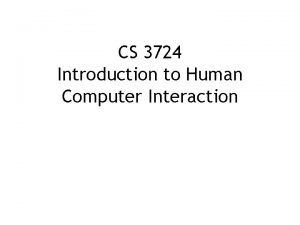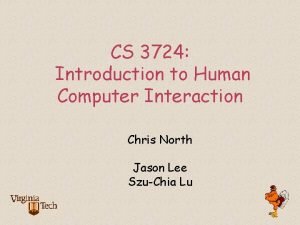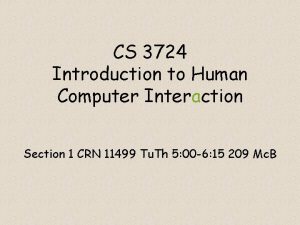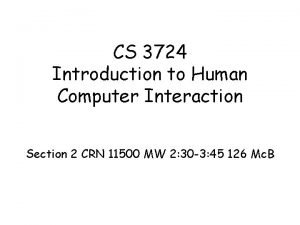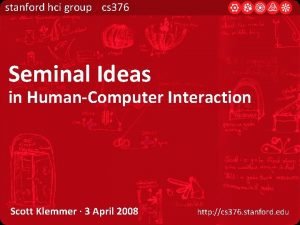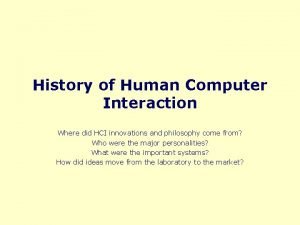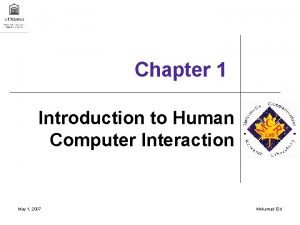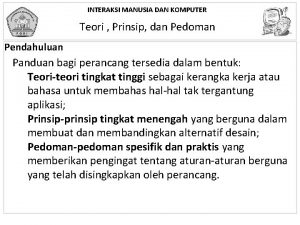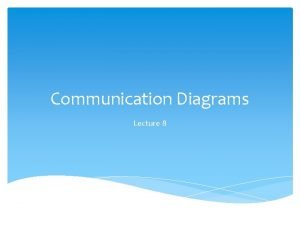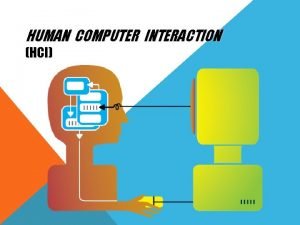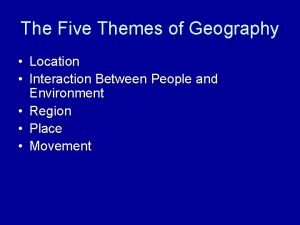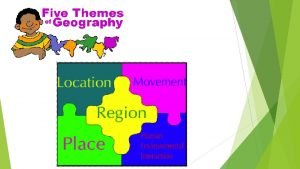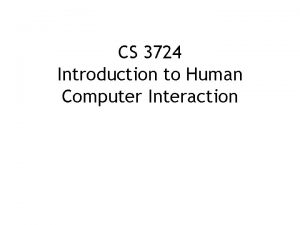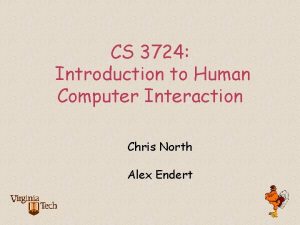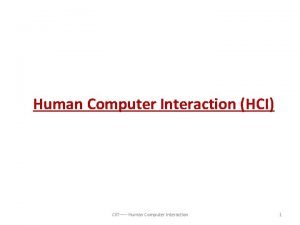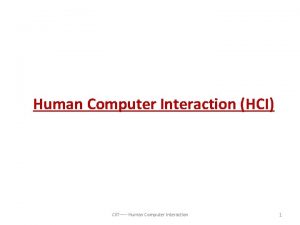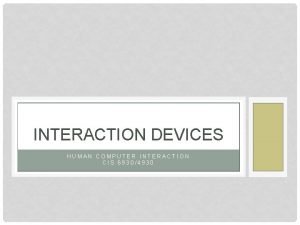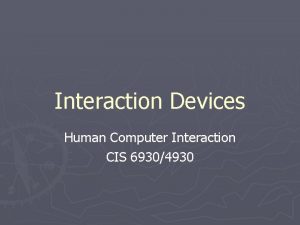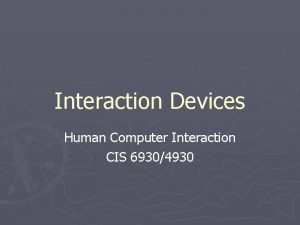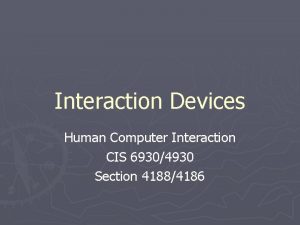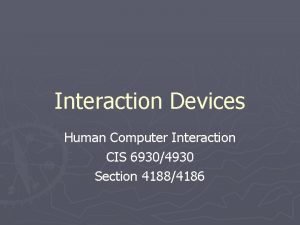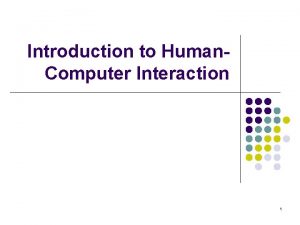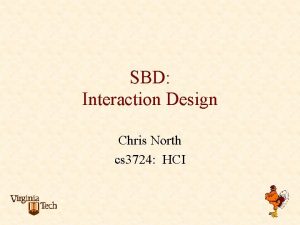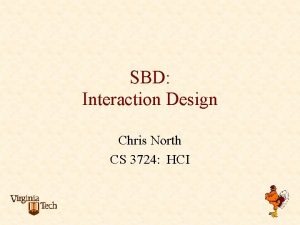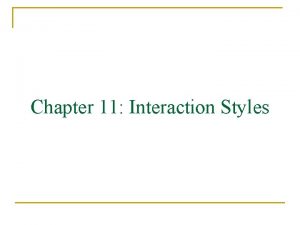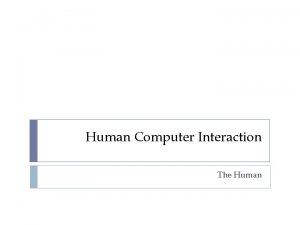CS 3724 Introduction to Human Computer Interaction Section


























- Slides: 26

CS 3724 Introduction to Human Computer Interaction Section 2 CRN 11500 MW 2: 30 -3: 45 126 Mc. B

Where Are We? About 1/4 through the Semester q Scenario-Based Design q Read Chapters 1 -5 q Lectures/exercises on: q q q q Team Building Users, (Front-End) Requirements Analysis, and Ethnography What is Design? Where Do Ideas Come From? Representations Formative Evaluations Information Visualization

Are We Meeting the Goals of Course ? q OFFICIAL VERSION Survey of concepts, theory, and practice. Interdisciplinary underpinnings. Evaluation of computer-based technology. User-oriented perspective: human (cognitive, social) and technological (i/o, interactions styles, devices). q Design guidelines, evaluation methods, participatory design, communication between users and system developers. q q q STEVE HARRISON’S VERSION q q Learn that HCI topic is both wide and deep. Design involves asking good questions Convince some of you that HCI is phat / cool Convince the rest of you that HCI expertise is needed in most computer projects

w. Ha. T q. Ue. St. Io. Ns Co. Me Up • w. Ha. T k. In. D o. F d. Es. Ig. N i. S “i. Nf. Or. Ma. Ti. On Vi. Su. Al. Iz. At. Io. N”? • Ar. E t. He. Re Ot. He. R Ki. Nd. S o. F h. Ci De. Si. Gn? • Wh. At Ot. He. R m. Et. Ho. Ds Ar. E u. Se. Fu. L t. O k. No. W? • An. D j. Us. T w. He. Re Is Th. E In. Te. Rf. Ac. E?

Today’s Agenda q CS 3724 so far q Kinds of HCI Design q q UE: Activity, Information, and Interaction Experience, Narrative, and Genre User-Centered Speculative q Methods q q Metaphor Periscope Role-playing Design Review

Today’s Agenda q CS 3724 so far q Kinds of HCI Design q q UE: Activity, Information, and Interaction Experience, Narrative, and Genre User-Centered Speculative q Methods q q Metaphor Periscope Role-playing Design Review

Some Kinds of Design q Activity q Information q Interaction q Experience q Narrative q Genre q User-centered q Speculative • UE: • Highest level of abstraction • Functionality • Activity Design Scenarios • Methods: • Wizard of Oz • Metaphor • Persicope

Some Kinds of Design q Activity q Information q Interaction q Experience q Narrative q Genre q User-centered q Speculative • UE: – – • Middle level of abstraction Information theory Presentation Info Visualization Methods: – Graphic design – Cog. Psych lab experiments – Sketches of screens

Some Kinds of Design q Activity q Information q Interaction q Experience q Narrative q Genre q User-centered q Speculative • UE: – Lowest level of abstraction – I/O – ergonomics • Methods: – Mental models – Performance optimization (e. g. Fitt’s Law) – Cog. Psych lab experiments

Some Kinds of Design q Activity q Information q Interaction q Experience q Narrative q Genre q User-centered q Speculative • Not In UE • Used in: – Theme park rides – Immersive games • Gestalt – “look and feel” – Crosses all UE Levels • Methods: – storyboard

Some Kinds of Design q Activity q Information q Interaction q Experience q Narrative q Genre q User-centered q Speculative • Not In UE • Used in: – Games – Interactive fiction • Literary/cinematic – Crosses all UE Levels – Scenarios users live in • Methods: – Role-playing

Some Kinds of Design q Activity q Information q Interaction q Experience q Narrative q Genre q User-centered q Speculative • Not In UE • Used in: – New media – Exhibit design • How is meaning communicated? – Crosses all UE Levels – What genres are possible? • Methods: – Deconstruction – Persicope – Recombinant construction

Some Kinds of Design q Activity q Information q Interaction q Experience q Narrative q Genre q User-centered q Speculative • Not In UE • Used in: – Most HCI • Think like a user – Crosses all UE Levels – Like SBD, but develops standards no scenarios • Methods: – GOMS – Storyboards – Participatory

Some Kinds of Design q Activity q Information q Interaction q Experience q Narrative q Genre q User-centered q Speculative • Not In UE • Used in: – Quickly done products • Come up with something unlike anything else – Crosses all UE Levels • Methods: – Analogies from totally unrelated areas

Today’s Agenda q CS 3724 so far q Kinds of HCI Design q q UE: Activity, Information, and Interaction Experience, Narrative, and Genre User-Centered Heroic q Methods q q Metaphor Periscope Role-playing Design Review

w. Ha. T w. Er. E a. Ll Th. Os. E m. Et. Ho. Ds Ag. Ai. N? q Wi. Za. Rd Of Oz q Me. Ta. Pho. R q p. Er. Si. Co. Pe q q q Gr. Ap. Hi. C d. Es. Ig. N Co. Gp. Sy. Ch La. B e. Xp. Er. Im. En. Ts Me. Nt. Al Mo. De. Ls Pe. Rf. Or. Ma. Nc. E o. Pt. Im. Iz. At. Io. N r. Ol. E-p. La. Yi. Ng De. Co. Ns. Tr. Uc. Ti. On Re. Com. Bi. Na. Nt Co. Ns. Tr. Uc. Ti. On Go. Ms St. Or. Yb. Oa. Rd. S p. Ar. Ti. Ci. Pa. To. Ry An. Al. Og. Ie. S f. Ro. M t. Ot. Al. Ly Un. Re. La. Te. D Ar. Ea. S

Methods we already know: q. Brainstorming q. Delphi planning method q. Hierarchical task analysis q. Morphological box q. Wizard of Oz q. Metaphor q. Persicope q. Graphic Design q. Cog. Psych Lab Experiments q. Mental Models q. Performance Optimization q. Role-playing q. Deconstruction q. Recombinant Construction q. GOMS q. Storyboards q. Participatory q. Analogies From Totally Unrelated Areas q. Concept Selection q. Design Review

Methods we don’t have time to learn right now: q. Brainstorming q. Delphi planning method q. Hierarchical task analysis q. Morphological box q. Wizard of Oz q. Metaphor q. Persicope q. Graphic Design q. Cog. Psych Lab Experiments q. Mental Models q. Performance Optimization q. Role-playing q. Deconstruction q. Recombinant Construction q. GOMS q. Storyboards q. Participatory q. Analogies From Totally Unrelated Areas q. Concept Selection q. Design Review

Methods we need to learn soon: q. Brainstorming q. Delphi planning method q. Hierarchical task analysis q. Morphological box q. Wizard of Oz q. Metaphor q. Persicope q. Graphic Design q. Cog. Psych Lab Experiments q. Mental Models q. Performance Optimization q. Role-playing q. Deconstruction q. Recombinant Construction q. GOMS q. Storyboards q. Participatory q. Analogies From Totally Unrelated Areas q. Concept Selection q. Design Review

Methods we’ll learn this week: q. Brainstorming q. Delphi planning method q. Hierarchical task analysis q. Morphological Box q. Wizard of Oz q. Metaphor q. Persicope q. Graphic Design q. Cog. Psych Lab Experiments q. Mental Models q. Performance Optimization q. Role-playing q. Deconstruction q. Recombinant Construction q. GOMS q. Storyboards q. Participatory q. Analogies From Totally Unrelated Areas q. Concept Selection q. Design Review

Role Playing q. Very much like Wizard of Oz q. Ideation / validation q. Method: q. Start with scenario q. Act out interaction q. Improvise q. Use props

Metaphor q. Ideation q. Method: q. Generate (I. e. brainstorm) analogs q. Re-describe activity in scenario using metaphor q. Develop representations based on metaphor q. Do not confuse metaphor with what is being represented!

Periscope q. Ideation / Validation q. Can be used with morphological box and/or brainstorming q. Method: q. Come up with “good” ideas q. Figure out what category they are in q. Then figure out other ideas in same category (space) q. Are they also “good” ideas?

Design Review q. Validation, Analysis, Teaming q. Like “claims” in SBD q. The compliment to brainstorming q. Form of reflection q. Method: q. Give alternative courses of action q. Golden Rule: focus on idea q. Articulate the position you coming from (that is, are you speaking as an expert, pretending to be the user, someone with a particular model of how the system works, etc. )

Today’s Agenda q CS 3724 so far q Kinds of HCI Design q q UE: Activity, Information, and Interaction Experience, Narrative, and Genre User-Centered Speuclative q Methods q q Metaphor Periscope Role-playing Design Review

For Wednesday: q q Team 7: Hall of Fame / Hall of Shame HW 3 (Visualization) Complete UE Chapter 5 Next Lecture: “Where is the interface” with more methods For Next Week: q Monday: q Team 8: Hall of Fame / Hall of Shame q Complete UE Chapter 6 q Wednesday: q Team Report 2 Due q Mid Term
 Introduction of computer
Introduction of computer Cs 3724 vt
Cs 3724 vt Cs 3724
Cs 3724 Cs 3724
Cs 3724 Stanford hci group
Stanford hci group What is icon in hci
What is icon in hci Paradigms of interaction in hci
Paradigms of interaction in hci Input output channel in human computer interaction
Input output channel in human computer interaction History of hci
History of hci Direct manipulation examples
Direct manipulation examples Human computer interaction chapter 1
Human computer interaction chapter 1 Pola pikir desainer imk dibawah ini adalah
Pola pikir desainer imk dibawah ini adalah Prinsip interaksi manusia dan komputer
Prinsip interaksi manusia dan komputer Human computer interaction syllabus
Human computer interaction syllabus Pengertian interaction
Pengertian interaction Alan dix
Alan dix Human computer interaction diagram
Human computer interaction diagram Ergonomics in human computer interaction
Ergonomics in human computer interaction Hci adalah
Hci adalah Human environment interaction definition geography
Human environment interaction definition geography Functional region
Functional region Human environment interaction in portland oregon
Human environment interaction in portland oregon Spatial interaction ap human geography
Spatial interaction ap human geography Egypt human environment interaction
Egypt human environment interaction What is human geography
What is human geography What is geography
What is geography Linguistic diversity ap human geography
Linguistic diversity ap human geography
